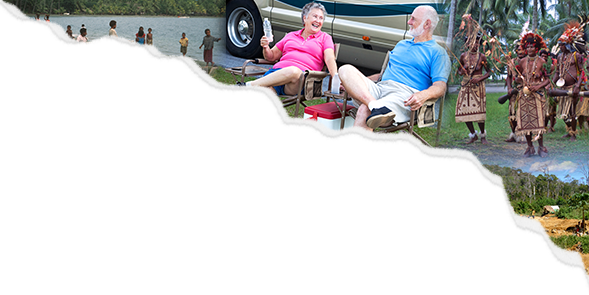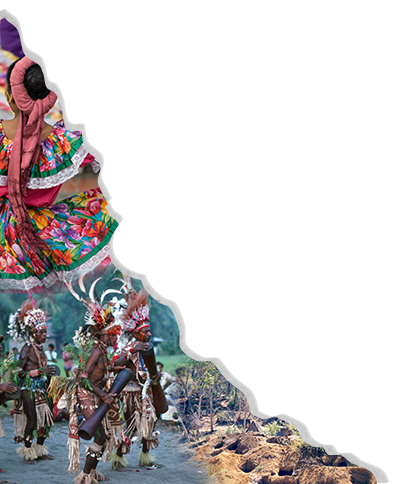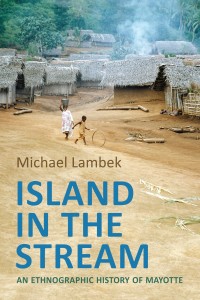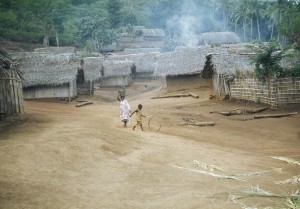The Scholarly Publishing program at University of Toronto Press has been producing the Anthropological Horizons series since 1991. The series is home to imaginative, immersive ethnographic works that engage a variety of topics, theoretical approaches, and methods of presentation with a goal of expanding both anthropological knowledge and the capacity of ethnography as a genre. In the interview below, UTP’s Acquisitions Editor for Social Sciences, Jodi Lewchuk, discusses the series’ most recent title: Island in the Stream: An Ethnographic History of Mayotte, which is authored by the series editor himself, Michael Lambek, current Department Chair in Anthropology at the University of Toronto and fellow of the Royal Society of Canada.
Jodi Lewchuk: First, congratulations on the publication of Island in the Stream: An Ethnographic History of Mayotte! It encompasses forty years of your fieldwork and offers snapshots of an evolving community on this East-African island. Tell me how this particular region and community came to be the focus of your work.
Michael Lambek: Mayotte was quite fortuitous. I was planning to go to Madagascar, a place I had first heard about as an undergraduate at McGill and then became the focus of interest of two of my professors in graduate school at Michigan. They had a grant with opportunities for several students, but very few of us took them up on it. Madagascar is a huge island, populated by people culturally and linguistically similar to one another but who live in very different physical environments and who had developed a variety of forms of political organization, ranging from egalitarian societies to a precolonial empire. I was planning to conduct research in the Antankarana kingdom of the northwest and had overly ambitious plans, somewhat along the lines of Edmund Leach’s Political Systems of Highland Burma, to look at transformations between more and less hierarchical and centralized forms of organization.
In February 1975, just after I had passed my comprehensive exams and had ticket in hand, the president of Madagascar, Richard Ratsimandrava, was assassinated six days after taking office. I was told that Madagascar would no longer welcome western foreigners and so a regional expert, Pierre Vérin, who had advised the Michigan project, suggested I go to the French colony of Mayotte instead. (Almost two decades later, when political conditions changed, I introduced Andrew Walsh to Antankarana country. His book Made in Madagascar: Sapphires, Ecotourism, and the Global Bazaar is also published by University of Toronto Press (2012) as part of the Teaching Culture series.)
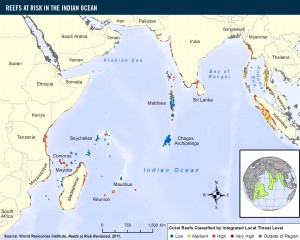 Frankly, I had never heard of Mayotte, but I didn’t really care as my goal was simply to live and learn about someplace hitherto undescribed in the anthropological literature and far from home. Vérin explained that Mayotte, a small island in the Comoro Archipelago near Madagascar, contained a large minority of Malagasy speakers and was about to undergo major social transformation. I would be able to document life before and after. In 1975 Mayotte was not easy to reach. I flew to Dar es Salaam and then to Moroni on the Grande Comore and from there to Mayotte, which at the time was a very sleepy backwater. There was no market or place to buy food and the first night we went to bed hungry.
Frankly, I had never heard of Mayotte, but I didn’t really care as my goal was simply to live and learn about someplace hitherto undescribed in the anthropological literature and far from home. Vérin explained that Mayotte, a small island in the Comoro Archipelago near Madagascar, contained a large minority of Malagasy speakers and was about to undergo major social transformation. I would be able to document life before and after. In 1975 Mayotte was not easy to reach. I flew to Dar es Salaam and then to Moroni on the Grande Comore and from there to Mayotte, which at the time was a very sleepy backwater. There was no market or place to buy food and the first night we went to bed hungry.
JL: I live in a neighbourhood in Toronto that has a bridge over the Don River inscribed with the phrase, “This river I step in is not the river I stand in.” It’s a reference to Heraclitus’s notion of panta rhei — that everything is in a state of constant change. This idea is very much at the heart of Island in the Stream – for both the Mahorais as a people and you as an anthropologist. Can you talk a bit about how the book uses this concept to break new ground as a form of ethnography?
ML: Heraclitus was on my mind as I wrote the book, in the sense that life is continuously in motion and the question for an ethnographer or social scientist is how to capture that. You can’t step into the same stream twice, but that isn’t so much because the stream has changed into another but more so that you can’t step out of it in the first place.
I was also more interested in people immersed in the stream of life, as it were, than someone ostensibly on the banks. In fact, none of us has that privileged position as detached onlooker who can choose to step in or out. That’s why the trajectory of my own life is relevant, though I certainly had the privilege of coming and going to and from Mayotte. In fact, the central metaphor of the book is not a river in which one is in or out of, but rather the horizon one shares, more or less of, with others. Moreover, if we move toward horizons, we have to acknowledge that the horizons are moving as well. As articulated by the philosopher Hans-Georg Gadamer, the concept of horizon applies to what is past as well as to what is future. A central concern of the book is to show that people’s actions are oriented not only to what they anticipate or imagine lies ahead, but also to changing understandings of their past (including past anticipations of the future). Hence, historical consciousness, critical awareness, and ethical discernment are important in ways that immersion in the stream of life does not capture as well.
What I consider novel in the book is the mode I call “ethnographic history.” Rather than composing either a synchronic ethnography or a purely historical account, I stack a series of ethnographic portraits based on successive visits — and in some cases written at different times in my career — alongside one another, such that together they provide a history. The successive portraits are not discrete from one another, as each of them addresses the ways people looked forward and back, and how actions at any moment are shaped by perceptions of what is anticipated and what is owed.
The snapshots also show what is continuous between them, as things change at different rates. The method enables me to draw on the insights of structure and thick description that only ethnography can provide alongside a recognition that is history’s domain, but also that of politics, that social life is temporally constituted and that change is intrinsic and necessary to it. Because of the privilege I had to revisit the same community multiple times across a 40-year span, I am able to produce an account that avoids the kind of static before-and-after quality that comes with a single “restudy,” one that hinges on the return of the ethnographer — stepping twice into the stream, as it were.
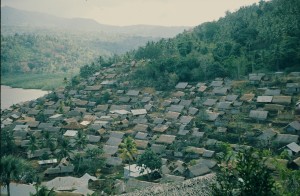 Moreover, thinking about the lives of people whom I have known across the stream of my own life encourages, I hope, a certain kind of humility and brings shared existential questions to the fore that are not captured in the ethnographer’s personal romance of a single period of research. I think of how the concept of “experience” in English is two distinct concepts in German. The naïve young ethnographer may have “an experience” (Erlebnis) — as I certainly did on my first visit to Mayotte and which remains for me the most memorable and life-changing — whereas the mature anthropologist looks back on cumulative “experience” (Erfahrung). A broader point here is that change is not the whole story but is always in relation to what remains continuous or to what a semiotician might call an “indexical origo.” This is the central question or tension of “identity,” whether we are talking about a community, a tradition, or the self.
Moreover, thinking about the lives of people whom I have known across the stream of my own life encourages, I hope, a certain kind of humility and brings shared existential questions to the fore that are not captured in the ethnographer’s personal romance of a single period of research. I think of how the concept of “experience” in English is two distinct concepts in German. The naïve young ethnographer may have “an experience” (Erlebnis) — as I certainly did on my first visit to Mayotte and which remains for me the most memorable and life-changing — whereas the mature anthropologist looks back on cumulative “experience” (Erfahrung). A broader point here is that change is not the whole story but is always in relation to what remains continuous or to what a semiotician might call an “indexical origo.” This is the central question or tension of “identity,” whether we are talking about a community, a tradition, or the self.
JL: There’s a lovely passage in the book in which you discuss the life’s work of a spirit medium on Mayotte. You describe her end goal as capturing “human flourishing.” How does this view of a creative and engaged way of living and conceptualizing everyday life inform your approach to anthropology, illustrated so vibrantly in Island in the Stream?
ML: There is an historical irony about that portrait of the spirit medium because several years later she became a highly disparaged member of the community and was considered to have practised sorcery against her relatives — seeking, that is, the very opposite of flourishing. It may be that I idealized her in the portrait written before that happened, but that doesn’t invalidate it; the change in her position is a further illustration of what we have been talking about with respect to how people’s lives and circumstances change and cannot be captured by a single snapshot.
But more importantly, I try to show how people act most of the time for what they think is the best. Until recently, much anthropology has been dominated by interest theory, the idea that people act selfishly or to maximize gain, or by conflict theory, which makes power central and assumes people try to dominate one another. Ironically, while these theories form the core ideas of liberalism and conservatism, respectively, as manifest in dominant places in the academy like economics or international relations, they have also been central to critical and progressive forms of social theory. Given the times in which we live, it is very difficult not to be cynical or to view people and social formations at their worst. But I want to say that if we take people simply as they are and as they see themselves or how they want to be, we see most people drawing on their capacities (albeit in relation to the constraints they face) and acting with courage, curiosity, creativity, and commitment, with interest in the world around them, and with concern for others.
Moreover, in this darkening period of our own history, it remains ever more important for anthropology to show that the world need not be as we ourselves experience it. The idea is not to romanticize others but to restore a balanced portrait of human action and to remember that social life can take a variety of forms. We need not submit to tyrants or to acquisitiveness. These concerns have led me in recent years to articulate a position on what I’ve called “ethical life.” Of course, it heightens the question of why good intentions do not preclude collectively bad results, and hence the importance of critical, dialectical, and complex social theory.
JL: Island in the Stream is, of course, part of the Press’s Anthropological Horizons series, which you’ve edited since its inception in 1991. How does Island’s innovative approach to ethnography capture the spirit of the series and set the tone for the kinds of proposals we’re looking for?
ML: In its focus on horizons within Mayotte, my book inadvertently drew on the same source in Gadamer that led me to title the series “Anthropological Horizons” back in 1990. (I guess that illustrates continuity, repetition, or being stuck, no less than the flow of change!). I am very proud of the series, which now contains 55 books. The series’ title “horizons” indicates we are open to variety of topics, theoretical perspectives, and modes of presentation and that we look to the future as we acknowledge the past.
We welcome serious and imaginative accounts that draw from sustained, immersive fieldwork and reflection and that exemplify and extend anthropological knowledge and the capacity of the ethnographic genre. Two features of our series that stand out, I think, are that manuscripts are rigorously reviewed and that the production values are high. Over the years we have greatly expanded our capacities with respect to marketing and distribution. We are also extremely fortunate to have the privilege of access to publication subsidies for Canadian authors.
JL: We’ll be launching Island in the Stream at the 2018 American Anthropological Association’s Annual Meeting in San José. You’ll be there to sign books and chat with attendees at the UTP booth on Friday, November 16, at 4pm. What is it about this book that you are most eager to share with readers?
ML: That is the most difficult question you’ve asked! I hope that readers will discover things for themselves. Readers from Mayotte can draw on the book to reflect further on their own history, while readers elsewhere might think further about the articulation of structure and change, ethnography and history, action and consciousness, and about systems of ceremonial exchange and performance that are a recurrent theme of the book. This is also the story about a unique form and trajectory of postcoloniality, one in which the inhabitants of Mayotte insisted that the colonizing power recognize them as equals and do so by further incorporating them within the French state rather than recognizing them outside it. In a situation already rife with irony, the unexpected tragedy is that this has led Mayotte to become a southern gateway to fortress Europe, now overflowing with migrants seeking livelihood and citizenship.
Michael Lambek is a Canada Research Chair and professor in the Department of Anthropology at the University of Toronto Scarborough.
